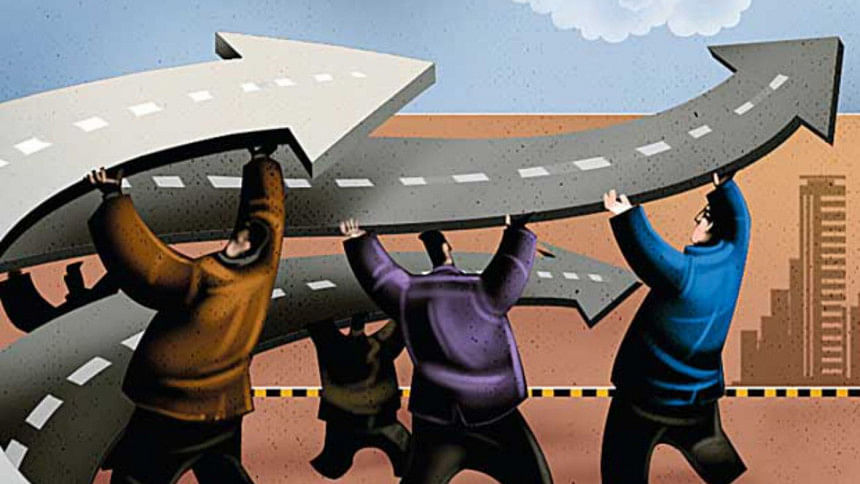The reality after seven years

We are in love with numbers. The government loves to show off the billions of dollars it has received in investment commitment from India and China. What it fails to say of course is that most of the mega projects are in a state of limbo. Take for instance our failure to fast-track the first tranche of Indian credit that was received in 2010. Indeed the execution of seven projects worth USD 699.07 million with Bangladesh Railway and Bangladesh Standards and Testing Institution (BSTI) has been waiting to be implemented for the last seven years. It has everything to do with our failure to implement projects and yet, we have gone on to take more Indian credit. Indeed, we have welcomed the second line of Indian credit (USD 2 billion) in 2016 and a third in the current fiscal (USD 4.5 billion) against which we have apparently undertaken 21 projects.
Things are not good. Because if the rate of implementation remains as it has been over the last seven years, we will merely be adding billions of dollars in credit with little to show in terms of project completion. When we can't get projects that were signed back in 2010 done, why on earth are we taking on more loans that will have to be paid back with interest? Precisely who are we trying to fool (except ourselves) that the country's economic backbone will be transformed if we do not get our house in order? These are not new questions, but have become much more pertinent today because we have huge investments headed our way from China (much of which will come in the form of loans and not grants).
According to a report published recently in a leading English daily, only eight projects out of 15 under the first Line of Credit (LoC) have been completed with the remaining seven (worth USD 699.07) still incomplete. The bulk of these projects (six) are being implemented by Bangladesh Railway and from what we understand, the biggest problem remains land acquisition and other procedural delays. The one BSTI is implementing has run into problems related to machinery faults but these should have been worked out by now.
So our major stumbling block to implementing any major project remains land acquisition and development. This has been a chronic problem, a thorn on our side for years. Unfortunately, policymakers have not done much to alleviate it. In an interview way back in 2013, the managing director of a major group of industries stated that, "It took me more than three years to acquire a 6-acre plot to set up a caustic soda plant, and the full process has not been completed yet." We certainly hope that he got his land and established his plant. For years, we have been planning to undertake a long-term industrial development plan that would take into account a mid to long-term land acquisition plan. And although the government has made public plans to establish 100 export processing zones, the dismal performance on the first tranch of the Indian LoC merely illustrates that those plans will in probability, remain plans on paper.
The typical answer anytime the issue is raised is that we are an overpopulated country with limited land. That of course is merely an excuse for inaction. Had that been the case, how do we see city states like Singapore and Hong Kong do magnificently well? One should be realistic about demands that foreign investors will make and the fundamental prerequisite of any venture will demand the provisioning of land. While the hullabaloo about infrastructure revolves around roads, highways and power, we seldom stop to dwell on the chronic shortage of land — the acquisition of land to be more precise that is giving the government a bad name. When will we get our heads out of the sand and come to realise that it is not political unrest, physical infrastructure or lack of power, but scarcity of land that is fast becoming the single most critical problem in our quest to undertake any major project?
What has changed in the last five years is that Bangladesh has been largely successful in garnering interest of regional powers to invest in much needed sectors of the economy. Now, the onus rests squarely on our shoulders if we can't get those projects off the ground. As land remains a precious commodity, we cannot allow for unplanned industrialisation to take place, which is precisely what has been happening over the past couple of decades. We have been taking precious farmlands to turn them into industry. Similarly we have witnessed the dumping of untreated industrial effluents into major river systems that have played havoc with both fish stocks and land fertility, because industry has been allowed to grow in and around major population centres (which usually grow up near water systems like rivers). This is hardly the best usage of land and it certainly is not sustainable.
Given our experience with the Indian LoC, policymakers need to start working on a long-term national land use policy today, that will chart out which areas of the country will be used solely for industry and which for agriculture. Such a policy will allow the government to cut through much of the problems it is facing today when the issue of land acquisition comes up, as it will keep coming up when we try to utilise our various lines of credit from foreign sources. The policy must be enacted into law (which will take the hassle out of lengthy court proceedings). Unless we take this step, meaningful industrialisation and the dream of turning Bangladesh into a middle income country will remain a dream.
The writer is Assistant Editor, The Daily Star.

 For all latest news, follow The Daily Star's Google News channel.
For all latest news, follow The Daily Star's Google News channel. 



Comments